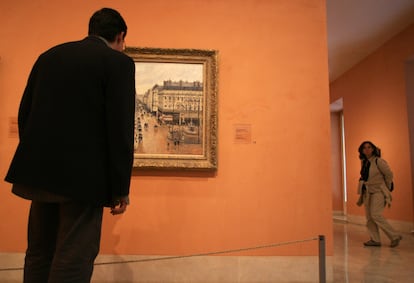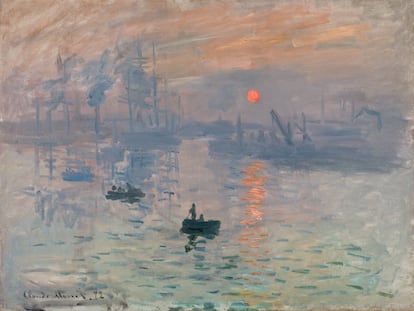California opens new chapter in the fight for Thyssen Museum’s Pissarro
A recently passed law provides opportunity to the family, who has been battling to get the painting back for 20 years. The legislation comes as a surprise after the last court decision ruled in favor of Spain’s right to keep the work


The work hung over the room that Claude Cassirer used as an office. It was a reproduction of Rue Saint Honoré, Afternoon, Rain Effect (1897), the piece by the impressionist painter Camille Pissarro that has been at the heart of a bitter, two-decades-long legal dispute between the Cassirer family, the Spanish government and Madrid’s Thyssen Museum. “I had it made for my father. They framed it beautifully. Sometimes it causes confusion, because when people see it, they think they’ve returned the piece to us,” says David Cassirer, Claude’s son and great-grandson of Lilly Cassirer Neubauer, the original owner of the artwork. Claude died in 2010 and Lilly in 1962.
The copy of the Pissarro original, which was plundered by the Nazis at the start of World War II, now hangs in 70-year-old David’s living room. “I look at it every day and in my mind, I speak to her. I tell her, ‘It will come back to me, it will come back to us,’” says Cassirer from Denver, where he lives. His hope that this will occur seemed to have been dashed in January, when a California appeals court ruled against the Cassirers, finding that Spain has the right to retain the piece, referencing previous decisions made by U.S. federal courts in 2015 and 2022. Three judges from the 9th U.S. Circuit Court of Appeals unanimously found that Spanish law took precedent over California legislation in the matter, reinforcing Madrid’s claim to the Pissarro — though Judge Consuelo Callahan did state in a dissenting vote that Spain should have voluntarily relinquished the painting.
But recently, the California government has breathed new life into the Cassirers’ claim. On September 16, Governor Gavin Newsom signed a law into effect that helps “residents recover art and other personal property stolen during the Holocaust or as a result of other acts of political persecution.” The signing took place at the Holocaust Museum Los Angeles, the governor flanked by members of the Cassirer family. “It is both a moral and legal imperative that these valuable and sentimental pieces be returned to their rightful owners,” said Newsom. The politician is currently considering some 900 new state laws, but typically only signs a handful of them into effect in person. Newsom himself made the call to turn this particular signing into a symbolic call for justice.
The piece was acquired in 1976 by Baron Hans Heinrich von Thyssen-Bornemisza after passing through the hands of various owners. His collection was sold to the Spanish Government in 1993. Lilly Neubauer, who was Jewish, was forced to sell the painting at the start of 1939 for 900 Reichsmarks ($360) in order to pay for a visa to leave Nazi Germany with her husband, a doctor from Munich, and go to England. The money was deposited into an account that Lilly never had access to. Lilly’s sister stayed in Germany to take care of their mother and eventually died at Auschwitz. Years later, Claude Cassirer discovered the whereabouts of the painting, which is valued at tens of millions of dollars, and tried to recover it through diplomatic means. When that didn’t work, in 2005, he began a legal battle to get it back, explains David Cassirer.

The newly enacted Assembly Bill 2867 began taking shape after the latest court decision. It was written by local legislator Jesse Gabriel, who, prior to his political career worked a lawyer, and litigated on behalf of families of Holocaust survivors seeking compensation for their work in Nazi concentration camps. This summer, the member of the state Assembly visited Spain as part of an energy and trade delegation. In his spare time, he went to the Thyssen to see Rue Saint-Honoré, Afternoon, Rain Effect.
“I thought that the work would be one of the star pieces, but that’s not the case. It’s in a wing with various other paintings. Returning it would be a minimal cost to the museum. The collection would continue to be impressive,” says Gabriel. “The friendliness and excellent attitude shown to us by the government representatives with whom we met seemed incongruent with the resistance to returning a painting that was stolen,” he adds. The law, which had bi-partisan support, cites the Cassirer case in its text, but Gabriel says it goes beyond this specific situation and those of others linked to the Holocaust: “It sends the message that it’s time to do the right thing.”
The family’s crusade has taken on new importance in the United States amid growing anti-Semitism. “Of the millions of works of art and cultural property stolen by the Nazis, countless objects still have not been returned to their owners. Today, too many governments, museums, dealers, galleries, and individuals still resist restitution efforts,” U.S. Secretary of State Anthony Blinken said in March at an event commemorating the 25th anniversary of the Washington Principles, a pledge signed by 44 nations, including Spain, to provide justice in the cases of art plundered by the Germans.
According to Sam Dubbin, the Cassirers’ lawyer alongside noted attorney David Boies, the law opens a new path for families litigating in the United States. “It makes it very clear that only California laws, and not foreign laws, such as Spanish law, can apply in a dispute over stolen art. It’s not just for Holocaust victims, but for anyone who has been stripped of art they own,” he says by phone. The law’s text only allows for the reclamation of art stolen up to 100 years before its enactment.
Other legal experts are skeptical about the new law’s scope. “It’s unconstitutional, it doesn’t stay within its jurisdiction,” says a lawyer familiar with the case who asked to remain anonymous. That source believes that the California Congress is trying to change the rules of the game because one side has not benefited from federal court rulings. “It is not up to California to take a position on issues that fall under U.S. federal law,” says the lawyer, who lives and litigates in the state.
Thaddeus Stauber, who has represented the Thyssen-Bornemisza Collection Foundation in the case for nearly two decades, says that Spanish property law is considered by international courts to be on par with that of Germany, the United Kingdom and other European nations, and that it is neither anti-Semitic nor morally questionable. The lawyer says that in 1958, the German government compensated the family with 120,000 Deutschmarks, the amount requested by Lilly Neubauer, to settle their claim. David Cassirer has said that he would be willing to return the money in exchange for recovering the painting.
David Cassirer has indicated that he would be willing to return the money in exchange for recovering the painting. His lawyer, Sam Dubbin, states that both the U.S. Ninth Circuit and the German courts agree that “Lilly never relinquished her right to the physical recovery of the painting.” Dubbin firmly rejects the belief that the family is trying to collect twice for the artwork.
Stauber says that after the court confirmed that the Thyssen is the legitimate owner of the painting, the appeals court ruled the case closed. The California Supreme Court has declined to re-open it and question Spanish law. After the ruling, the Cassirer family can only petition for the Supreme Court to take another look at the case, which they already did once in 2022, under the new Californian law. Still, the lawyer says that legal precedent indicates that the state cannot pass laws that give special treatment to its citizens when it comes to modern restitution claims stemming from World War II, particularly since the property in question is not in California.
David Cassirer sees this legal battle as “unnecessary and somewhat excessive.” “My father never would have believed that this law was necessary because a thief can’t transfer the ownership of something that was stolen. Not in a million years did we think that Spain would maintain such a stubborn position, waiting for all of us Cassirers to die,” he says. His family is now preparing, with the help of the Jewish Federation, to open a new chapter in a legal controversy that, in 2025, will have lasted 20 years.
Sign up for our weekly newsletter to get more English-language news coverage from EL PAÍS USA Edition
Tu suscripción se está usando en otro dispositivo
¿Quieres añadir otro usuario a tu suscripción?
Si continúas leyendo en este dispositivo, no se podrá leer en el otro.
FlechaTu suscripción se está usando en otro dispositivo y solo puedes acceder a EL PAÍS desde un dispositivo a la vez.
Si quieres compartir tu cuenta, cambia tu suscripción a la modalidad Premium, así podrás añadir otro usuario. Cada uno accederá con su propia cuenta de email, lo que os permitirá personalizar vuestra experiencia en EL PAÍS.
¿Tienes una suscripción de empresa? Accede aquí para contratar más cuentas.
En el caso de no saber quién está usando tu cuenta, te recomendamos cambiar tu contraseña aquí.
Si decides continuar compartiendo tu cuenta, este mensaje se mostrará en tu dispositivo y en el de la otra persona que está usando tu cuenta de forma indefinida, afectando a tu experiencia de lectura. Puedes consultar aquí los términos y condiciones de la suscripción digital.
More information
Archived In
Últimas noticias
Mexico seeks to shore up its defenses following US incursion in Venezuela
Hope gives way to uncertainty among Venezuelan exiles in the US after Maduro’s capture
Cubans look to Venezuela fearfully after Trump’s incursion: ‘We could be next’
The operation in Venezuela to capture Maduro threatens to widen the cracks in the MAGA movement
Most viewed
- Alain Aspect, Nobel laureate in physics: ‘Einstein was so smart that he would have had to recognize quantum entanglement’
- Gilles Lipovetsky: ‘If you want to live better and fall in love, take Prozac, don’t look to philosophy’
- Alvin Hellerstein, a 92-year-old judge appointed by Bill Clinton, to preside over Maduro’s trial in New York
- Cuba confirms death of 32 of its citizens in the US attack against Venezuela
- Why oil has been at the center of Venezuela-US conflicts for decades










































